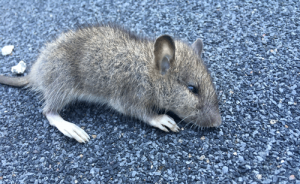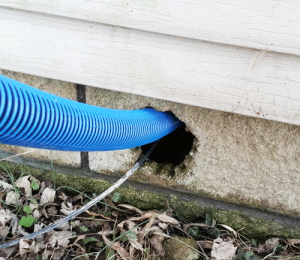What should I do if I find an orphaned or abandoned mouse?
When you find an abandoned mouse, there are a few essential steps that should be immediately taken.
- Within 2-4 hours, the mouse needs to be hydrated and fed. The mouse also needs to be fed every 2 hours, around the clock. As the orphan gets older, feeding frequency can decrease.
After 3-4 weeks, feeding frequency can be cut in half. What do I feed a mouse, you ask?- 10oz of goat milk

- 10 oz of sterilized water
- 1 raw egg yolk
- 1 cup of whole yogurt
- 1.2 tsp of corn syrup
- 1 tsp of mayonnaise
- 10oz of goat milk
- Next, you need to make sure to keep the mouse warm. Mice need to be held at a temperature of 80 degrees Fahrenheit. You can use a heated blanket on a low setting to secure a resting place for your mouse.
- Bedding: You can use fabrics such as t-shirts or any other cloth that the mouse’s toenails will not get stuck in to create a bed for your mouse.
- Some problems you may come across include:
- Dehydration and bloating
- Not eating
- Bathing
- Respiratory problems
- Injury and more
- Solutions to these problems:
To avoid dehydration and bloating – You can add Pedialyte to your mouse’s diet when the mouse has reached a few weeks old, at least. This contains electrolytes that can help with these issues. Feed this by syringe or paintbrush, whichever is more comfortable for you and your mouse.
Mouse not eating? Some mice don’t like the electrolytes of Pedialyte. Mix together the Pedialyte and your homemade formula to encourage the mouse to eat.
Bathing your mouse – Make a lukewarm bath for the mouse in a bowl appropriate to your mouse’s size. Do not use soap! Soap can be toxic to your mouse if ingested. Allow the mouse to swim around, but not for too long to reduce stress. Using a Q-tip to lightly brush the mouse’s fur, and dry with a paper towel or napkin.
Respiratory Issues – Orphans are often born to unwell mothers, leaving a potential for health issues. These mothers often abandon their offspring because of health issues as well. Feeding the mouse slowly and making sure the temperature of the formula or Pedialyte is not too warm for the mouse can help with these issues.
Avoiding Injury – Make sure to always hold the mouse carefully and not to squeeze as this can cause internal injury on the mouse’s body. Always carry the mouse over a surface. This is in case the mouse happens to fall, it is a shorter fall to a surface than to the ground.
TIPS (Do Not):
- Feed the mouse cow’s milk (oat milk, goat milk, and others can work) Cow’s milk is too hard to digest for the mouse.
- If the mouse was caught by a cat, you will need to examine it for wounds immediately. The saliva of a cat is lethal to small animals like mice if left untreated. Seek attention from an exotic vet for antibiotics. If put on antibiotics by a vet, after the treatment is over, replenish your mouse’s gut with yogurt.
Good Luck to you and your mouse!
Additional Advice
If you come across an  abandoned baby mouse, there are a number of efforts you can take to ensure that the mouse is well cared for. Firstly, it is essential to understand why it’s so important to care for an abandoned mouse in the first place. Adult mice are much more difficult to care for, and often carry deadly diseases such as the Hantavirus disease. Moreover, throughout their lives, mice tend to develop innate fears of humans. Because of this hard-to-dissolve fear, the best thing to do for an adult mouse is simply to release it into the wild. However, in the case of a baby mouse, it likely has not developed the survival skills essential to its kind, due to its abandonment. Without an adult mouse, it cannot take care or fend for itself in the wild. The best way to guarantee its survival is to care for the mouse by hand. It has been shown that such hand-raised mice can grow up to be extremely affectionate and loving towards their human foster parents. Additionally, in comparison to domesticated mice, hand-raised wild mice are typically more adept. The most tricky question can often be whether or not the mouse is abandoned. It is possible that the mother mouse has simply been scared away or that she is searching for food. At this point, you should leave the nest alone and check back within four to six hours. After this time, check to see if the mouse has been fed by observing its stomach. If there is a white band, it has likely been fed. If not, the mother has likely either abandoned the mouse or is deceased. Before touching the mice, call your local rehabilitation office because wild mice will have a much greater chance of survival under professional care. Be careful if you do have a local rehabilitation center, that they are planning to care for it rather than using it to feed other animals. If you have no rehabilitation center that will adequately care for the mouse, you may want to take the mouse into your care.
abandoned baby mouse, there are a number of efforts you can take to ensure that the mouse is well cared for. Firstly, it is essential to understand why it’s so important to care for an abandoned mouse in the first place. Adult mice are much more difficult to care for, and often carry deadly diseases such as the Hantavirus disease. Moreover, throughout their lives, mice tend to develop innate fears of humans. Because of this hard-to-dissolve fear, the best thing to do for an adult mouse is simply to release it into the wild. However, in the case of a baby mouse, it likely has not developed the survival skills essential to its kind, due to its abandonment. Without an adult mouse, it cannot take care or fend for itself in the wild. The best way to guarantee its survival is to care for the mouse by hand. It has been shown that such hand-raised mice can grow up to be extremely affectionate and loving towards their human foster parents. Additionally, in comparison to domesticated mice, hand-raised wild mice are typically more adept. The most tricky question can often be whether or not the mouse is abandoned. It is possible that the mother mouse has simply been scared away or that she is searching for food. At this point, you should leave the nest alone and check back within four to six hours. After this time, check to see if the mouse has been fed by observing its stomach. If there is a white band, it has likely been fed. If not, the mother has likely either abandoned the mouse or is deceased. Before touching the mice, call your local rehabilitation office because wild mice will have a much greater chance of survival under professional care. Be careful if you do have a local rehabilitation center, that they are planning to care for it rather than using it to feed other animals. If you have no rehabilitation center that will adequately care for the mouse, you may want to take the mouse into your care.
Carefully place the mouse in a lined box with clean, and soft tissues to make it comfortable. After handling the mouse, you must wash your hands. Mice are known to often carry a dangerous disease called the Hantavirus. The baby mouse should also be kept warm, between 75 and 90 degrees Fahrenheit. You can ensure this by either placing a hot water bottle under a towel in their box or an electric heating pad placed on its lowest setting. Be sure that the heating source is not too hot for the mouse by checking the temperature with your hand. After 2 to 3 weeks of this, a healthy mouse will be able to maintain its body temperature without the help of a heating source. Once you have decided to take the mouse into your care, you still may have several options. Perhaps, you already care for a domestic mouse with babies. If this is the case, your domestic mouse may be willing to serve as a foster mother to the abandoned mouse. For this adoption to be successful, the abandoned mouse should be similar in size and physical features to the foster mother’s babies. If this is the case, the mother will be more willing to care for the abandoned mouse. The best way to execute this process is to separate the mother from her babies so that she cannot see them while placing the wild mouse alongside the others. Using clean bedding from the nest of the foster mother, rub the wild mouse to disguise its scent.
The mother will be much more receptive to accepting a baby that looks and smells like her own. Gently, while avoiding touching the other babies as much as possible, place the newborn wild mouse among the new babies. Then return the mother to her cage, slightly separated from the rest of her nest. The mother must find her babies herself without being coaxed towards the group. It is best to leave the clan alone during this process. Hovering over the cage can cause the mother to become so upset, that she simply abandons all the babies. There is a high risk that the mother will not accept the foster baby, so this delicate process is best left as undisturbed as possible. You can check to ensure that all babies are being fed adequately by observing their milk bellies, a white visible band along their stomach, and ensuring that the babies are not losing weight. If you do not already have a mother mouse with newborn babies, you may want to consider purchasing a foster mother from a pet store. It may be possible to find a mother who has just given birth at a pet store, and attempt to assimilate the orphaned baby with the clan. Finding a mother for the abandoned baby is the best thing to do because a mother has a much greater change of successfully feeding and raising newborns. If you are unable to find a foster mother for your abandoned mouse, you will need to raise and feed the mouse on your own. Baby mice need to be fed as often as once every two hours. This can mean that you must be prepared for some sleepless nights. The formula you use to feed your baby can vary greatly. People have been known to use whole, fresh goat milk, Soyalac human formula, kitten milk replacer, or puppy formula. Powdered formulas are preferred because you can mix a fresh bath each day in comparison with liquid formulas, which must be used within three days of being opened. To nurse the baby mouse, a baby bird feeding
syringe with a fine curved tip or even a small doll nursing bottle will be effective. Use the nurser to feed the baby mouse often, careful not to allow any formula to enter their lungs. You can check this by observing that no milk is bubbling from their nose. You should be very careful with this step because if milk enters their lungs, aspiration may occur which is essentially the process of drowning. The best way to avoid this is to keep the mouse upright when feeding it, never allowing it to rest on its back. If you do see a bubble form, flip the baby over to prevent any more liquid from entering its lungs. Be careful not to overfeed the mouse, checking to ensure that they are well fed by the emergence of a white patch in the middle of their belly, a milk belly. The formula should be at a warm temperature and it will take approximately five minutes to feed the babies. Despite feeding the baby regularly, it may still appear to be underweight or even lose hair. This is often the case with hand-raised babies and should not be cause for discouragement. With time, the babies will grow back their hair and gain weight. After feeding each baby, you will need to gently massage their abdomen and rectal area using a damp and warm cloth. This process will stimulate their urinary flow and allow them to pass solid waste. If your mouse experiences diarrhea, it is likely a result of being overfed, although a veterinarian will be able to diagnose other causes. In this case, dehydration is a major concern and excessive milk will simply continue to irritate the digestive tract. In this situation, milk should be replaced with an electrolyte solution containing salt and chemicals for human babies. When the babies begin to open their eyes in the process of weaning, you can begin to add dry baby cereal to their formula. They will no longer require frequent nightly feedings. At three weeks, the babies will also no longer require the bottle for feedings and may begin to feed off of a dish. Gradually make the switch from a bottle to a dish a few times per day, integrating foods such as oatmeal and baby food into the mixture. They may even begin to nibble on fresh fruits such as apples, carrots, seeds and will require plenty of freshwater. Mice are often very messy eaters, so after they finish their meals, it will be necessary to clean them up. By this point, your babies will have made it very far! In addition, you will be left with some greatly affectionate pets who will likely have formed a great bond with you. Baby mice are exceptionally difficult to raise and with time and proper care and nutrition, they will grow to be nearly equivalent in size to other wild mice.
